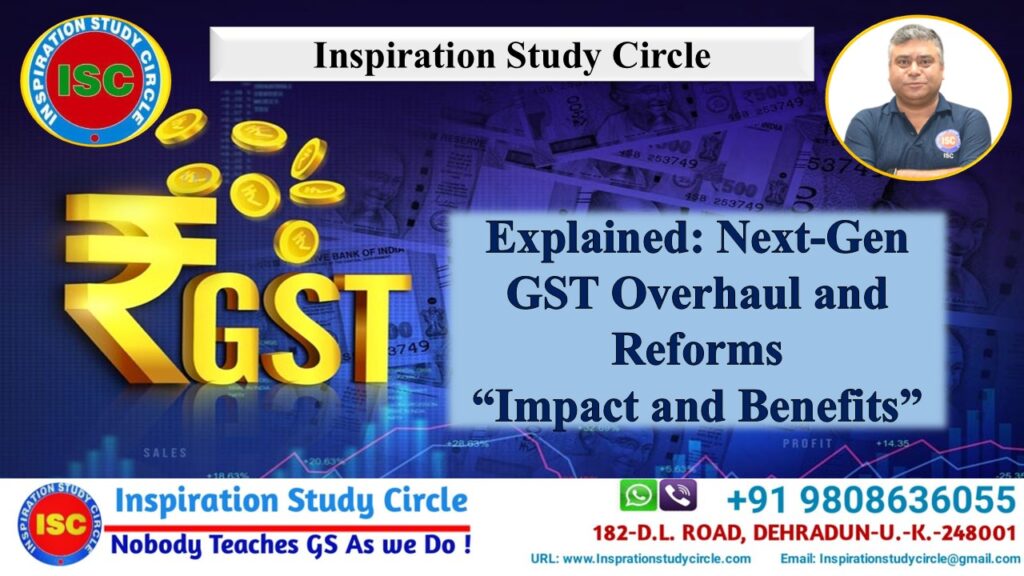Explained: Next-Gen GST Overhaul and Reforms
Table of Contents
The GST Council in its 56th meeting on 3rd September, 2025, made the recommendations relating to changes in GST tax rates; provide relief to individuals, the common man, the aspirational middle class, and measures for facilitation of trade in GST. The reduced GST rates will be effective from 22nd September 2025.
The major processed food products on which GST rates have been reduced are placed in Annexure I.
The idea of GST was first proposed in 2000, with an Empowered Committee of State Finance Ministers set up to study sales tax reforms. The Goods and Services Tax (GST), introduced on 1st July 2017, by the 101st Constitutional Amendment Act, is India’s most significant indirect tax reform since Independence. By bringing together multiple central and state taxes into a single, unified system, GST created a common national market, reduced the cascading of taxes, simplified compliance, and improved transparency. Over eight years, GST has steadily evolved through rate rationalisation and digitalization, becoming the backbone of India’s indirect tax framework.
In line with the PM’s vision, the GST Council has recommended a comprehensive reform package that includes rate rationalization with a simplified two-slab structure (5% and 18%), sweeping rate reductions across sectors, with focus on common-man, labour-intensive Industries, farmers and agriculture, health, and key drivers of the economy. These recommendations are based on consensus among all members of the GST Council to make GST simpler, fairer, and more growth-oriented.
In a historic move to simplify the Goods and Services Tax(GST), GST Council in its 56th meeting has reduced the GST structure from four slabs (5%, 12%, 18%, 28%) to two main rates—5% (merit rate) and 18% (standard rate) along with a 40% special rate for sin/luxury goods. These changes come into effect from September 22, 2025.
The food-processing sector has been a major beneficiary of this rationalization of tax rates, with most products witnessing a decline to 5% GST slab.

Benefits of the GST rate rationalization:
- Simplified tax structure
- Reduced prices for almost all food products, thus promoting ease of living.
- Lower prices will boost demand for food products, expansion of investment, and employment generation.
- Support for Manufacturing: Correcting inverted duty structures boosts domestic value addition and exports.
- Better revenue generation in the sector through a broader base and better compliance.
- Resolving Classification Issues – Similar goods and services will be placed in the same rate slab, reducing disputes and lowering litigation costs.
This rationalization of GST to lower levels provides a variety of stimulants to the sector and encourages a virtuous cycle of economic growth through the following:
- Simplified tax structure: The simplified tax structure brings uniformity across food items with a reduced number of tax slabs. A stable tax environment will help businesses plan long-term investments, encourage compliance, and drive economic growth.
- Reduced prices: The consumers shall witness overall reduced food prices, making staples more affordable. This, in turn, stimulates consumer demands, and FMCG and packaged food businesses are expected to see an uptick in sales. Additionally, the simplification aids businesses by reducing compliance costs and lowering litigation risk.
- Inverted duty structure:The new structure helps correct inverted duty cases, e.g., when inputs were taxed higher than finished products. This provides immediate relief for strengthening the value chains in the food sector, improving liquidity, especially for MSMEs, reducing working capital blockage, and promoting domestic value addition.
- Resolving Classification Issues:The new structure eliminates classification disputes arising from varying tax rates for similar products. For example, packaged vs. loose paneer or parathas previously had different rates, but now follow a clearer structure and greatly reduce classification disputes.
- Other procedural reforms:Besides rate cuts, the Council approved procedural reforms through streamlined registration and return filing, provisional refund mechanisms especially for inverted duty claims, and implementation of GSTAT (Goods and Services Tax Appellate Tribunal) to expedite appeal resolution and reduce litigation.
- Boost to processed food industry:Overall, the manufacturing sector is set for a boost. The lower GST rates on consumer goods and the resultant lower prices could potentially set off a virtuous cycle of increased demand and growth for the industry.
The overall industry has the following positives:
- Consumption:GST rate cuts will result in lower retail prices, which in turn will increase demand for manufactured products, including processed food products.
- Investment:With increased demand and positive business sentiment and a reduction in compliance burden, investments are expected to rise.
- Employment:With increased demand, expected rise in investment and formalisation of industry, more employment opportunities are expected to be generated in the sector and the economy as a whole.
- Increased income level for farmers and food processors:The incomes and remunerations of the farmers and food processors are expected to rise by way of an increase in consumption and investment in the economy, increasing the food-processing infrastructure, level of processing, and value addition, and a reduction in post-harvest losses.
Impact of the Next-Generation GST Reforms on the Indian Economy:
These reforms are designed not just to reduce tax rates, but to create a virtuous cycle of growth.
- Lower Prices, Higher Demand: Cheaper goods and services increase household savings and stimulate consumption.
- Support for MSMEs: Reduced rates on inputs like cement, auto parts, and handicrafts lower costs and make small businesses more competitive.
- Ease of Living: A two-rate structure means fewer disputes, quicker decisions, and simpler compliance.
- Wider Tax Net: Simpler rates encourage compliance, expanding the tax base and improving revenues.
- Support for Manufacturing: Correcting inverted duty structures boosts domestic value addition and exports.
- Revenue Growth: As seen in past reforms, lower rates with better compliance increase collections.
- Economic Momentum: Lower costs → higher demand → larger tax base → stronger revenues → sustainable growth.
- Social Protection: Exemption of GST on insurance and essential medicines strengthens household security and access to healthcare.
Together, these reforms ensure that GST is citizen-centric, business-friendly, and aligned with India’s global growth ambitions.
Way Forward for India with the New GST Reforms:
The “Next-Gen” GST reforms, effective from September 22, 2025, represent a significant way forward for India by
Addressing many of the challenges of the past while positioning the economy for stronger, consumption-led growth. How reforms address past challenges: –
- Complexity: The new two-slab structure of 5% and 18%, along with a 40% rate for luxury items, directly tackles the previous multi-tier system that led to complexity and classification disputes. The simplified rates make the system more transparent and easier to follow.
- High costs and compliance burden: For Micro, Small, and Medium Enterprises (MSMEs) and other small businesses, simplified registration, faster refunds, and lower compliance costs will ease their burden. Previously, complex requirements significantly increased the cost of doing business.
- Inverted duty structure: Corrections to inverted duty structures in sectors like textiles, footwear, and fertilizers will make domestic products more competitive. This frees up working capital for manufacturers and supports the “Atmanirbhar Bharat” (Self-Reliant India) initiative.
- Tax disputes: A simpler rate structure is expected to reduce the number of tax disputes and lessen the litigation costs for businesses.
- Consumption and demand: The previous multi-tiered system and higher rates on consumer durables weighed on urban and rural consumption. The new reforms reduce rates on a wide array of goods, making them more affordable and stimulating demand.
- Healthcare costs: By reducing or eliminating GST on essential medicines, medical devices, and health insurance, the reforms directly address the issue of high healthcare costs for ordinary citizens.
Path to future growth: The new reforms are designed to create a virtuous cycle of growth driven by multiple factors.
- Stimulating consumption: Cheaper prices on everyday essentials, food products, and consumer durables will increase household savings and boost domestic demand, a key driver of India’s economic growth.
- Empowering manufacturing: Lower taxes on inputs and the correction of the inverted duty structure will strengthen domestic manufacturing. Sectors like electronics, textiles, and renewable energy are poised to benefit significantly.
- Expanding the tax base: A more straightforward tax system is expected to encourage greater voluntary compliance and the formalization of the economy, expanding the tax base and improving revenue buoyancy for the government.
- Targeting inclusive prosperity: The reforms focus on affordability for citizens, support for MSMEs and farmers, and enhanced access to healthcare. This makes GST a tool for inclusive prosperity rather than just revenue collection.
- Building resilience against global headwinds: By stimulating domestic consumption, the reforms help insulate the Indian economy from external shocks, such as global supply chain issues or tariffs from major trading partners.
- Digital integration: The focus on digital filing and faster refunds continues to strengthen the digital infrastructure of the GST Network (GSTN), which will improve efficiency and help to curb tax evasion.
Potential challenges on the horizon: While the path forward appears promising, some challenges will require continued attention
- Transition burden: The immediate transition may place a burden on some sectors with high inventory purchased at older rates, though the impact is expected to soften over time.
- State revenue: While increased collections are anticipated, some industrialized states may experience a sharper short-term revenue loss. Addressing fiscal equity concerns and ensuring a smooth transition for these states will be crucial.
- Digital infrastructure: The GSTN infrastructure will require continued upgrades to handle automated compliance checks and address any invoice mismatches.
- Tax disputes: While the new structure aims to reduce disputes, classification disagreements could still arise. Quarterly reviews and clear oversight will be needed.
- Inclusion of excluded items: Moving forward, including items like petroleum and alcohol into the GST framework is a long-term goal that will eliminate cascading tax effects and further strengthen the system.
Disclaimer: The above article is based on the information provided by the various editions of the Press Information Bureau.
Inspiration Study Circle provides a wide variety of information on the tips of your fingers. You can easily access us on WhatsApp, Facebook, and Instagram. Our website is frequently updated for the candidates’ benefit.
Recent Post

The Viksit Bharat – Guarantee for Rozgar and Ajeevika Mission (Gramin) Bill, 2025
The Viksit Bharat – Guarantee for Rozgar and Ajeevika Mission (Gramin) Bill, 2025 Table of Contents The Viksit Bharat – Guarantee

How to Prepare for UKPCS 2026 in Six Months
How to Prepare for UKPCS 2026 in Six Months Table of Contents ISC- How to Prepare for UKPCS 2026 in

UKPSC Upper and Lower PCS Combined Batch for 2026- 2027
UKPSC Upper and Lower PCS Combined Batch for 2026-2027 Table of Contents Unlocking Uttarakhand’s Civil Services: The Power of UKPCS

Explained: Russian President Vladimir Putin’s State Visit to India
Explained: Russian President Vladimir Putin’s State Visit to India Table of Contents Russian President Vladimir Putin conducted a state visit

UPPSC Upper PCS 2025: Mains Test Series and Answer Writing
UPPSC Upper PCS 2025: Mains Test Series and Answer Writing Table of Contents Inspiration Study Circle- Dehradun The UPPSC PCS

Explained: The Sanchar Saathi App
The Sanchar Saathi App Table of Contents The Sanchar Saathi app is a security and user-protection platform developed by India’s Department of Telecommunications (DoT) to help users manage mobile connections, report fraud, and locate lost phones
